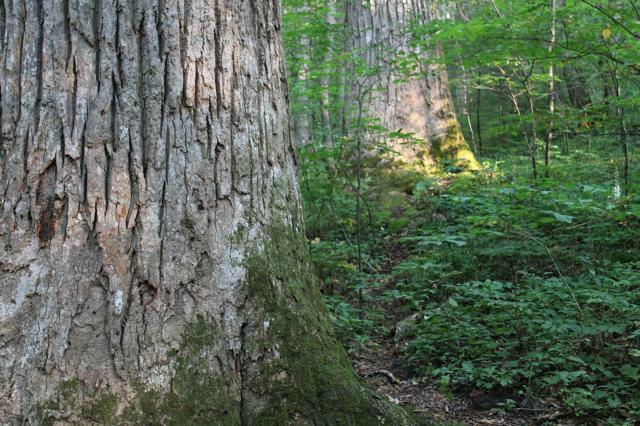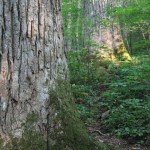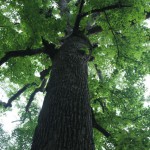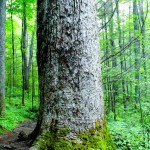- Capturing history: Old-growth forests have captivated Western North Carolinians for generations. North of Asheville, a new wayside exhibit on the Blue Ridge Parkway above Curtis Creek commemorates the Weeks Act, the 1911 legislation that initiated the land purchases for the fledgling National Forest system. Photo by Susan Andrew
- Grandfather trees: Large, old trees inspire reverence in many observers. With the opening of a new exhibit on the Blue Ridge Parkway, the Park Service and the Forest Service recently marked the 100th anniversary of the Weeks Act, the landmark legislation that launched a major period of land conservation in the eastern U.S. Photo by Susan Andrew
- Let it grow: The Forest Service recently marked the anniversary of landmark legislation that spawned a major period of land conservation in the 20th century, enabling forests damaged by aggressive logging to heal. Yet some WNC acres were never logged; local conservation organizations are documenting where. Photo by Susan Andrew
Each year, some 40,000 visitors walk the loop trail that ambles beneath Joyce Kilmer Memorial Forest’s majestic canopy. Trees up to 400 years old tower over a rich carpet of ferns and wildflowers, and huge logs sport thick blankets of green moss dotted with more flowering herbs. A recent rededication ceremony marked the memorial’s 75th anniversary (see July 27 Green Scene).
Old growth gives modern ecologists an idea of what the region’s climax forests might have been like when Europeans first arrived in these parts. And while the Graham County preserve may be Western North Carolina’s best-known old-growth forest, it’s not the only one, local experts say. Although decades of industrial-scale logging in the region claimed millions of acres of our original primary forest, there were some places early 20th-century logging crews just couldn’t reach.
The upper reaches of Curtis and Mackey creeks above Old Fort are one such area, and late last month, the U.S. Forest Service and the National Park Service unveiled a new wayside exhibit on the Blue Ridge Parkway, overlooking the Curtis Creek watershed. The exhibit commemorates the 100th anniversary of the Weeks Act, the landmark 1911 legislation that authorized the purchase of this tract: the first national forest land in the eastern United States.
The law spawned a major period of public land conservation in the 20th century, enabling forests damaged by aggressive logging, soil erosion and subsequent fires to heal — and protecting the headwaters of streams that now provide drinking water to countless downstream communities.
That first purchase comprised 8,100 acres owned by the Burke McDowell Lumber Co., for which the government paid $7 per acre. Now part of the Pisgah National Forest’s Grandfather Ranger District, the area is visible from the Parkway’s Laurel Knob Overlook. Offering hiking trails, waterfalls and the Curtis Creek Campground, the area features many typical old-growth characteristics: mature trees, extensive moss development, big logs decaying on the forest floor, and a wealth of microhabitats at every level, from floor to canopy.
It’s also home to the largest recorded tree in Pisgah: a tulip poplar measuring 5 feet 9 inches in diameter, discovered by WNC Alliance biologist Josh Kelley. Since the mid-’90s, the grass-roots environmental group has mounted an ongoing campaign to document the region’s remaining old-growth forests.
Curtis Creek’s neighbor to the east, the Mackey Creek watershed, was also largely spared the logger’s ax and therefore contains significant amounts of old growth, independent forest historian Rob Messick explains. Both drainages provide high-quality drinking water to the town of Marion, notes Messick, a key figure in the Alliance’s efforts.
To identify places that might harbor uncut forests, Messick spent several years reviewing land surveys early foresters performed for the fledgling federal agency. Better-publicized efforts at Biltmore Estate have overshadowed some key chapters in this early period of public-forest restoration, he maintains.
Even as the estate was bringing in the European-trained Gifford Pinchot and Carl Schenck to provide advice on forest restoration, others were coming at the issue from a different direction, says Messick, who’s preparing his findings for publication. He cites the work of William Ashe, who pursued “an American style of forestry that makes sense here: a more geographic and ecological approach to forest typing.”
Ashe’s methodology reflected an understanding of natural landforms and slope position which, in turn, determine such key forest conditions as moisture availability, Messick argues.
“It was a more geographically consistent model,” he asserts; the Europeans, on the other hand, were “doing a more agricultural thing,” dividing forests into stands (not unlike a garden) and estimating timber yield.
And even if it’s not immediately obvious when viewed from the Laurel Knob pull-off, stresses Messick, the expanse down below the new exhibit boasts some of the state’s best examples of old growth. When he and colleagues explored the place on foot, they found a vertical rock face and waterfall — an obvious barrier to logging crews.
Above it stood a prime example of unlogged forest, occupying “a unique hanging shelf on the right fork of Hickory Branch, very well-formed, with large trees, white basswood, sugar maple, ash and lots of poplar,” Messick recalls. Another uncut area nearby is where Kelley spotted the record tulip poplar.
“Managing the first tract of land establishing eastern national forests is truly a privilege and an honor,” says District Ranger John Crockett, adding that area residents “can be proud of this local history that helped restore and protect the forests of Western North Carolina.”
— Susan Andrew can be reached at 251-1333 ext. 153, or at sandrew@mountainx.com.







Before you comment
The comments section is here to provide a platform for civil dialogue on the issues we face together as a local community. Xpress is committed to offering this platform for all voices, but when the tone of the discussion gets nasty or strays off topic, we believe many people choose not to participate. Xpress editors are determined to moderate comments to ensure a constructive interchange is maintained. All comments judged not to be in keeping with the spirit of civil discourse will be removed and repeat violators will be banned. See here for our terms of service. Thank you for being part of this effort to promote respectful discussion.